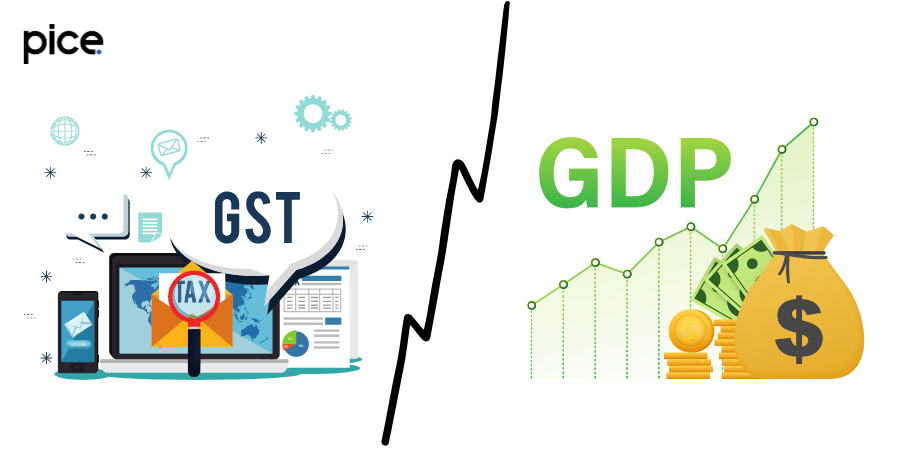Key Takeaways
- GST Introduction: GST, introduced in India on July 1, 2017, streamlined the tax system by replacing various indirect taxes with a unified framework.
- Calculating ATT involves aggregating various supply values across states, adjusting for reverse charge mechanism supplies, and excluding GST from the turnover.
- E-commerce Challenges: E-commerce faces unique ATT calculation challenges, including managing high transaction volumes and interstate supplies.
- Legal Framework: ATT is governed by GST laws and regulations, with compliance aided by GST-compliant software and professional advisory services.
- Future of ATT: Technological advancements and policy changes will likely influence ATT management, including AI, blockchain, and digital economy considerations.
The GST has brought about a significant change to the tax environment in India by streamlining tax systems and guaranteeing compliance. Adjusted total turnover is a key component of GST and a statistic that has a big impact on input tax credit and tax liabilities. Businesses must comprehend this idea in order to handle GST efficiently.
GST and its Components
Introduced on July 1, 2017, the Goods and Services Tax (GST) has significantly changed the indirect taxation environment in numerous nations, most notably India.

Aiming at creating a single, unified Indian market, GST simplifies the complex payment structure that was previously in place, replacing many indirect taxes levied by both the central and state governments.
Components of GST
The GST is made up of a number of essential parts, all of which are intended to simplify the country’s tax code for goods and services. The Union Territory Goods and Services Tax (UTGST Territory Tax), the State Goods and Services Tax (SGST), the Central Goods and Services Tax (CGST), and the Integrated Goods and Services Tax (IGST) are some of these components.
A closer look at each of these elements is provided below:
- Central Goods and Services Tax (CGST)
The CGST is a tax that the Central Government collects on intra-state sales, such as those that take place within the same state. The CGST replaces previous central taxes such as the Central Excise Duty, Services Tax, and additional duties of customs at the national level.
- State Goods and Services Tax (SGST)
SGST is collected by the State Government on an intra-state sale. This component of GST replaces taxes such as the State Sales Tax, VAT, luxury tax, and entertainment tax. Essentially, when a transaction occurs within a single state, both CGST and SGST are levied, and the revenue is shared between the central and state governments.
- Union Territory Goods and Services Tax (UTGST)
Similar to SGST, UTGST is levied on the supply of goods and services in any of the Union Territories of India. It functions alongside CGST in Union Territories without their own legislatures, ensuring a standardized tax rate across territories and states alike.
Integrated Goods and Services Tax (IGST)
IGST is a tax on the inter-state supply of goods and services, as well as on imports and exports. The Central Government’s collection of IGST ensures that state taxes do not become a cost to the interstate buyer, facilitating the smooth transfer of tax credits from one state to another. The IGST mechanism allows the importing state to claim the credit of the tax paid under IGST, promoting a nationwide common market.
The Dual GST Model
India’s GST model is a dual one, incorporating both Central and State GST. This model ensures that both the Central and State governments have concurrent jurisdiction over the taxation of goods and services, allowing them to collect tax at the same rate.
A unique feature of this model is the GST Council, which includes representatives from both the Central and State governments. The Council is tasked with making decisions regarding the GST law, including rates, exemptions, and the threshold for registrations.
What is Adjusted Total Turnover?
Adjusted Total Turnover is the sum of all the taxable and exempt supplies, exports of goods and/or services, and inter-state supplies of a person with the same Permanent Account Number (PAN). Under the reverse charge mechanism, it takes into account the turnover of goods that are subject to taxation by a different party.
It essentially encompasses the gross turnover of a taxpayer across all states and union territories, excluding certain transactions where tax is not directly payable by the supplier.
Components of Adjusted Total Turnover
To understand ATT more comprehensively, it’s essential to break down its components:
- Taxable Supplies: These are the supplies on which GST is applicable. It includes all goods and services sold or provided that are liable for tax under GST.
- Exempt Supplies: Supplies on which GST is not levied. This includes products and services that fall outside the scope of GST or are expressly exempt by law.
- Exports of Goods and/or Services: These are supplies made outside the domestic tariff area. Exports are treated as zero-rated supplies under GST, meaning exporters can refund claims on the tax paid on inputs.
- Inter-state Supplies: These are supplies where the location of the supplier and the place of supply are in different states or union territories.
The total of these components, after adjusting for reverse charge supplies, constitutes the Adjusted Total Turnover. It is important to note that ATT does not include the value of inward supplies on which tax is payable by a taxable person on a reverse charge basis, as these are considered the responsibility of the recipient of the supply.
Role in GST Compliance and Benefits
ATT plays a crucial role in various aspects of GST compliance and offers several benefits:
- Determining Eligibility for Composition Scheme: Small taxpayers with an ATT below a specific threshold can opt for the Composition Scheme, which allows them to pay GST at a reduced rate, subject to certain conditions.
- Computation of Input Tax Credit (ITC): ATT is used to determine the eligibility and limit for availing ITC under the GST law. The accurate calculation of ATT ensures that businesses can maximize their ITC claims, thereby reducing their overall tax liability.
- Fulfilling Compliance Requirements: Understanding and accurately calculating ATT is essential for GST returns Filing, audits, and other compliance requirements.
Calculation of Adjusted Total Turnover

The calculation of Adjusted Total Turnover (ATT) in the context of the Goods and Services Tax (GST) is crucial for businesses to determine their tax liability accurately and to comply with GST regulations effectively.
The process involves summing up various types of supplies made by a business, adjusted for specific exclusions. Here’s a step-by-step guide to calculating ATT:
Step 1: Aggregate the Turnovers
Start by aggregating the turnovers from different categories of supplies across all the states or union territories under the same PAN. These categories include:
- Taxable Supplies: All goods and services sold that are liable for GST, excluding the value of inward supplies on which tax is payable by the recipient under the reverse charge mechanism (RCM),.
- Exempt Supplies: Supplies that are exempt from GST. These could be specific goods or services that the GST law exempts.
- Non-GST Supplies: Supplies that are outside the purview of GST, like petrol, diesel, and alcoholic liquor for human consumption.
- Exports (including deemed exports): Goods and services sold to customers outside India which are treated as zero-rated supplies under GST.
- Inter-state Supplies: Supplies made from one state to another, including supplies to SEZs (Special Economic Zones) or SEZ developers.
Step 2: Adjust for Reverse Charge Mechanism (RCM) Supplies
Subtract the value of supplies where tax is paid on a reverse charge basis. In reverse charge scenarios, the recipient of the goods or services is liable to pay GST instead of the supplier. These should not be included in the supplier’s ATT since the liability to pay tax shifts from the supplier to the recipient.
Step 3: Adjust for Taxes
It’s important to note that the GST (CGST, SGST/UTGST, IGST) component should not be included in the turnover. ATT focuses on the value of supplies made, not on the tax collected on those supplies.
Step 4: Include Adjustments for Amendments or Credit/Debit Notes
If there have been any adjustments made to the value of supplies due to the issuance of credit or debit notes or amendments to invoices, these should be accounted for in the calculation of ATT. This ensures that the turnover reflects the actual turnover of supplies made during the relevant period.
Practical Example
Let’s consider a practical example for a clearer understanding:
- Taxable Supplies: INR 10,00,000
- Exempt Supplies: INR 2,00,000
- Non-GST Supplies: INR 1,00,000
- Exports: INR 3,00,000
- Inter-state Supplies to SEZ: INR 4,00,000
- Inward supplies on RCM: INR 50,000
Calculation:
Total Supplies (Taxable + Exempt + Non-GST + Exports + Inter-state Supplies) = INR 20,00,000
Subtract Inward supplies on RCM: INR 20,00,000 minus INR 50,000 = INR 19,50,000
Adjusted Total Turnover: INR 19,50,000
The Role of Adjusted Total Turnover in GST
The role of Adjusted Total Turnover (ATT) in the Goods and Services Tax (GST) regime is multifaceted, significantly impacting how businesses calculate their tax liabilities, claim input tax credits (ITC), and comply with GST regulations.

When analyzing a taxpayer’s operations throughout all states and union territories using a single Permanent Account Number (PAN), ATT is an essential statistic. A closer look into ATT’s function inside the GST structure is provided below:
- Determining Eligibility for GST Schemes
One of the primary roles of ATT is to determine the eligibility of businesses for various GST schemes, such as the Composition Scheme. This scheme allows qualifying small taxpayers to pay GST at a lower rate and with fewer compliance requirements based on their turnover.
The ATT is frequently used as the qualifying level, underscoring its significance for small and medium-sized businesses (SMEs) looking to gain from streamlined tax procedures.
- Calculation of Tax Liabilities
ATT directly influences the calculation of a business’s tax liabilities. Since it encompasses the aggregate value of all taxable supplies, exempt supplies, and exports, ATT forms the basis on which tax liabilities may be computed, particularly for businesses engaged in a mix of taxable and non-taxable activities. By understanding their ATT, businesses can more accurately estimate their GST dues.
- Input Tax Credit (ITC) Reconciliation
The concept of ATT also plays a vital role in the reconciliation of ITC. Businesses can claim ITC on their GST payments against their taxable supplies, and ATT is crucial for determining the maximum amount of ITC that can be claimed.
Proper calculation of ATT helps in ensuring that businesses do not claim more ITC than they are eligible for, thereby avoiding potential penalties for non-compliance.
- Facilitating Inter-state Transactions
From a compliance standpoint, accurate reporting of ATT is crucial for GST filings and audits. The GST authorities may use the ATT as a basis for evaluating the accuracy of tax payments and claimed credits.
The ATT is frequently used as the qualifying level, underscoring its significance for small and medium-sized businesses (SMEs) looking to gain from streamlined tax procedures.
- Strategic Planning and decision-making
Beyond compliance, understanding and monitoring ATT can aid businesses in strategic planning and decision-making. Businesses may learn more about their operational performance, spot growth patterns, and decide on expansion, diversification, or consolidation plans by tracking variations in ATT over time.
Common Mistakes and How to Avoid Them
Navigating the Goods and Services Tax (GST) framework involves complex calculations and strict compliance requirements, particularly concerning Adjusted Total Turnover (ATT).
Calculating ATT incorrectly can result in inaccurate tax returns, which can be penalized, subject to audits, and even damage one’s reputation. Here, we look at typical ATT errors and how to prevent them so that correct financial reporting and GST compliance are guaranteed.
Common Mistakes
- Misclassification of Supplies
One frequent error is the misclassification of supplies as taxable, exempt, or non-GST. Misclassifying can skew the ATT, affecting eligibility for schemes like the Composition Scheme and the accurate calculation of tax liabilities.
How to Avoid: Stay updated on GST laws and classifications. Utilize GST council resources or consult tax professionals to correctly classify supplies.
- Overlooking Inter-state Supplies
Businesses sometimes fail to properly account for inter-state supplies when calculating ATT. This oversight can lead to incorrect calculation of IGST and misallocation of tax revenue between states.
How to Avoid: Implement a robust accounting system that tracks the place of supply and includes inter-state supplies in the ATT calculation.
- Ignoring Exempt Supplies
Exempt supplies, including sales of non-GST goods and services, must be included in ATT calculations. Overlooking these can result in an underreported turnover, affecting tax liability and eligibility for GST schemes.
How to Avoid: Ensure that all exempt supplies are accounted for by regularly reviewing GST laws and exemptions.
- Inaccurate Allocation of Inputs for Mixed Supplies
Businesses offering both taxable and exempt supplies often misallocate inputs between these categories, leading to incorrect ATT calculations and ITC claims.
How to Avoid: Use a consistent and lawful method for allocating inputs between taxable and exempt supplies, ensuring accurate ATT calculations and ITC claims.
- Failing to Update Records for Returns and Cancellations
Returns, cancellations, and discounts can significantly affect the ATT if not promptly and accurately recorded.
How to Avoid: Maintain real-time, accurate records of all transactions, including returns and cancellations, to ensure they are reflected in the ATT.
- Not Including Supplies Made on Behalf of Others
Supplies made on behalf of others, under principal-to-agent or agent-to-principal transactions, must be included in the ATT calculation. Failure to do so can lead to underreporting.
How to Avoid: Clearly understand the GST implications of principal-agent relationships and ensure all transactions are correctly reported in the ATT.
- Relying on Manual Calculations
Manual calculations increase the risk of errors in the ATT calculation due to the complexity and volume of data involved.
How to Avoid: Invest in GST-compliant accounting software that automates ATT calculations, reducing the risk of human error.
The Impact of Adjusted Total Turnover on Businesses
Adjusted Total Turnover (ATT) under the Goods and Services Tax (GST) framework has profound implications for businesses operating within its purview. ATT’s impact spans various aspects of business operations, from financial planning and tax compliance to strategic decision-making.

Knowing how ATT influences business processes and financial health is crucial for entities aiming to optimize their operations under GST. Here’s an in-depth look at the impact of ATT on businesses:
- Tax Liability and Compliance
ATT plays a critical role in determining a business’s tax liability. It is a key factor in calculating the tax payable under the GST regime, influencing both the rate and the amount of tax due.
A higher ATT could mean a higher tax liability, making it essential for businesses to accurately calculate and report their turnover.
Accurate ATT computation is also necessary for timely filings and adherence to tax legislation in order to maintain GST compliance. Inconsistencies or errors might lead to audits, penalties, and interest on past-due taxes, all of which could be detrimental to the business’s profitability.
- Eligibility for GST Schemes
The eligibility for various beneficial GST schemes, such as the Composition Scheme, is determined based on the ATT. This scheme provides simpler compliance requirements and lower tax rates for businesses that generate less than a specific amount of income.
Consequently, small and medium-sized businesses (SMEs), who stand to gain a great deal from these programs and have an impact on their operational efficiency and cost-effectiveness, must comprehend and accurately calculate ATT.
- Input Tax Credit (ITC) Reconciliation
ATT affects the entitlement and reconciliation of Input Tax Credit (ITC), a mechanism that allows businesses to reduce their GST liability by the amount of tax paid on purchases.
The accurate calculation of ATT is essential for maximizing ITC claims, directly impacting cash flow and profitability. Incorrect ATT figures can lead to discrepancies in ITC claims, resulting in denied credits or additional liabilities after audits.
- Strategic decision-making
Businesses use ATT as a metric for strategic planning and decision-making. For instance, understanding the ATT can help businesses decide whether to expand operations or enter into new markets, as this could affect their GST liabilities and compliance requirements.
- Financial Planning and Budgeting
The effects of ATT on cash flows and tax obligations have an effect on financial planning and budgeting. Businesses may improve cash flow management, prepare for tax payments, and allocate resources more effectively when ATT is forecasted accurately. Forecasting is especially important in industries with erratic turnover or where seasonal trends have an impact on supply and sales.
- Market Competitiveness
The impact of ATT extends to market competitiveness. Businesses that effectively manage their ATT to leverage beneficial GST schemes or optimize their ITC claims can potentially lower their operational costs. Better margins, competitive pricing tactics, and an improved market position can all result from this advantage.
Adjusted Total Turnover and E-commerce
E-commerce businesses encounter unique challenges and considerations when it comes to calculating and managing Adjusted Total Turnover (ATT) under the Goods and Services Tax (GST) framework.
Here are key pointers highlighting the relationship between ATT and e-commerce:
- Nationwide Operations: E-commerce platforms often conduct business across multiple states and union territories, necessitating the inclusion of all interstate sales in the ATT calculation.
- High Volume of Transactions: The sheer volume of transactions, including sales, returns, and exchanges, complicates the calculation of ATT, requiring meticulous record-keeping and sophisticated accounting systems.
- Tax Collected at Source (TCS): E-commerce operators are subject to TCS under GST, which affects the ATT calculation. TCS amounts must be accurately accounted for and reported.
- Exclusion from Composition Scheme: E-commerce operators cannot opt for the Composition Scheme, influencing their strategic tax planning and operational structuring.
- Input Tax Credit (ITC) Reconciliation: The high volume and complexity of transactions challenge the ITC reconciliation process, making accurate ATT calculation crucial for maximizing ITC claims.
- Reverse Charge Mechanism (RCM) Transactions: E-commerce businesses dealing with RCM transactions need to carefully account for these in their ATT calculations, as they impact the net GST liability.
- Digital Goods and Services: The sale of digital goods and services adds another layer of complexity to ATT calculations, especially when it comes to determining the place of supply and applicable taxes.
- Intermediary Services: E-commerce platforms providing intermediary services must consider these transactions in their ATT calculation, adhering to specific GST provisions applicable to intermediaries.
- International Sales: For e-commerce businesses engaging in exports, these transactions are considered zero-rated and must be included in ATT calculations, impacting tax liabilities and ITC eligibility.
- Technology Utilization: Advanced GST-compliant software solutions are essential for e-commerce businesses to manage their ATT accurately, facilitate tax compliance, and streamline ITC reconciliation.
- Compliance and Audits: Accurate ATT calculation and reporting are critical for GST compliance, minimizing the risk of audits, penalties, and legal challenges.
- Strategic Decision Making: Understanding the implications of ATT on tax liabilities and compliance requirements aids e-commerce platforms in strategic planning, pricing, and market expansion decisions.
- Market Competitiveness: Effective ATT management can provide a competitive edge, allowing e-commerce businesses to optimize their pricing strategies and improve profitability.
Legal Framework Surrounding Adjusted Total Turnover

The legal framework surrounding Adjusted Total Turnover (ATT) within the Goods and Services Tax (GST) system is established through various provisions in the GST laws and rules. This framework sets out the definitions, calculation methodologies, and implications of ATT for businesses.
Understanding this legal context is crucial for compliance and strategic financial planning. Here’s an overview of the legal framework pertaining to ATT:
GST Act and Rules
- Definition and Inclusion: According to the GST laws, aggregate turnover is the total value of all taxable supplies (excluding inward supplies on which a person pays tax under the reverse charge mechanism), exempt supplies, exports of goods or services or both, and interstate supplies made by people with the same Permanent Account Number. Adjusted Total Turnover adjusts this definition for specific purposes, such as eligibility for certain schemes or benefits.
- Composition Scheme Eligibility: The GST Act outlines the eligibility criteria for the Composition Scheme, including turnover limits, which are based on the concept of aggregate turnover, a closely related concept to ATT. Businesses must understand their ATT to assess eligibility for such schemes accurately.
- Input Tax Credit (ITC) Reconciliation: The GST laws specify how businesses can claim ITC and highlight the importance of accurate ATT calculation for proper ITC reconciliation and utilization.
- Tax Collection at Source (TCS) for E-Commerce: Specific provisions relate to e-commerce operators and mandate the collection of tax at source, which impacts the calculation of ATT for suppliers operating through these platforms.
Legal Interpretations and Clarifications
- Advisories and Circulars: The GST council and tax authorities periodically issue advisories, circulars, and clarifications regarding the calculation and implications of ATT, providing guidance to businesses on compliance requirements.
- Case Law: Various legal cases and judgments have helped clarify the application and scope of ATT within the GST framework. These cases often address disputes related to the calculation of ATT, eligibility for schemes based on ATT, and related compliance issues.
- Audit and Compliance Checks: Legal provisions regarding GST audits and compliance checks underscore the importance of accurately calculating and reporting ATT. Misrepresentation or errors in ATT calculation can lead to legal scrutiny, penalties, and interest.
Compliance and Reporting
GST Returns: Businesses are required to report their turnover in their GST returns. The legal framework provides detailed instructions on how to include various components of turnover, underscoring the significance of ATT in these filings.
Annual Reconciliation Statement: The GST laws mandate the submission of an annual reconciliation statement, where ATT calculations play a crucial role in reconciling the tax paid with the tax liability as per the financial statements.
Strategic Implications
Business Structure and Operations: Legal considerations surrounding ATT may influence business decisions regarding structure, operations, and inter-company transactions to optimize GST implications.
Cross-border Transactions: For businesses involved in imports and exports, the legal framework provides specific guidelines on how these transactions impact ATT and GST liabilities.
Tools and Resources for Managing Adjusted Total Turnover
Managing Adjusted Total Turnover (ATT) effectively is important for GST compliance and financial optimization. Here’s a concise overview of tools and resources that can aid businesses in handling ATT accurately:
- GST Compliance Software: Automated solutions like Pice, Tally, Zoho Books, and ClearTax GST offer features for accurate ATT calculation, GST filing, and ITC management.
- GST Portal: The official GST website provides resources for filing returns, paying taxes, and accessing circulars and notifications relevant to ATT on the GST portal.
- Accounting and ERP Systems: Advanced systems like SAP and Oracle include GST modules that help manage financial transactions and calculate ATT across various business operations.
- Tax Advisory Services: Professional firms and tax consultants offer specialized advice and can assist in managing ATT calculations and GST compliance strategies.
- Online Calculators: Some websites and GST toolkits offer online calculators for preliminary ATT estimations, useful for quick checks and planning.
- E-Learning Platforms: Websites like Coursera, Udemy, and the GSTN’s own training modules offer courses on GST management, including aspects related to ATT.
- Government Publications: The Central Board of Indirect Taxes and Customs (CBIC) and the GST Council publish guides, FAQs, and circulars that clarify ATT calculation and reporting requirements.
Future of Adjusted Total Turnover in GST
The future of Adjusted Total Turnover (ATT) within the Goods and Services Tax (GST) framework is likely to evolve in response to changing tax policies, technological advancements, and the dynamic nature of global and domestic markets.
Several factors will shape the trajectory of how ATT is calculated, managed, and utilized in the GST context:
- Policy Changes and Legal Reforms
Simplification and Clarity: Efforts to simplify GST rules and provide clearer guidelines for ATT calculation can be expected. This includes potential amendments to simplify the tax return filing process, making it easier for businesses to calculate and report their ATT accurately.
Threshold Adjustments: The GST Council may revise the turnover thresholds for various schemes, including the Composition Scheme, which could impact how businesses approach their ATT calculations.
- Technological Integration
Advanced Software Solutions: The integration of AI and machine learning in accounting and GST software will enhance the accuracy and efficiency of ATT calculations. Businesses might be burdened less by these technology, which can automate intricate calculations and adjust to changes in regulations.
Blockchain for Transparency: Blockchain use has the potential to transform ATT management and GST compliance. Immutable transaction records provided by blockchain technology can lower fraud and guarantee turnover reporting transparency.
- Digital Economy and E-commerce Growth
Adapting to the Digital Economy: As digital transactions continue to grow, GST policies may evolve to better accommodate the nuances of e-commerce, digital services, and the gig economy. This could include specific guidelines for calculating ATT in these sectors.
Cross-border Transactions: The increasing volume of international digital transactions will necessitate refined rules for ATT calculations that consider global e-commerce and service delivery, impacting GST liabilities and credits.
- Increased Compliance and Scrutiny
Data Analytics for Compliance: The GST authorities are likely to leverage data analytics more extensively for compliance monitoring, including analyzing ATT data. This could lead to more targeted audits and scrutiny based on discrepancies in ATT reporting.
Real-time Reporting: The future might see a shift towards real-time data sharing between businesses and GST authorities, facilitating more accurate and timely ATT calculations and compliance checks.
- Sustainability and Social Responsibility
Incentives for Sustainable Practices: GST policies may introduce incentives or schemes that encourage sustainable business practices, impacting how ATT is calculated for businesses engaged in environmentally friendly activities.
- Education and Awareness
Enhanced Training and Resources: Increasing focus on education and resources to help businesses, especially SMEs, understand and manage their ATT effectively. This includes workshops, online courses, and comprehensive guides tailored to different industry sectors.
Conclusion
The future of managing Adjusted Total Turnover within the GST framework will increasingly rely on businesses’ ability to integrate and accurately apply these key concepts to their operations. As the landscape of taxation evolves with technological advancements and regulatory changes, staying informed and adaptable is paramount.
By understanding the intricacies of GST compliance, including the accurate calculation of turnover, timely tax payments, and effective management of refund applications, businesses can ensure financial health and regulatory compliance. This proactive approach not only aids in navigating the complexities of GST but also positions businesses for sustainable growth and success in the dynamic economic environment.
💡Don’t let GST payments slow down your export business. Download Pice GST Payment App now and streamline your international trade operations!
FAQs
What is the adjusted total turnover in GST?
Adjusted Total Turnover in GST is the sum of all taxable and exempt supplies, exports of goods and/or services, and inter-state supplies of a person with the same Permanent Account Number (PAN). It does not include the value of inward supplies for which a person is responsible for paying tax on a reverse charge basis. It is used to calculate the eligible input tax credit. This concept helps businesses accurately determine their tax liabilities and input tax credit entitlements by considering their comprehensive turnover and adjusting for specific exclusions as defined under the GST law.
How is ATT different from aggregate turnover?
Adjusted Total Turnover (ATT) and Aggregate Turnover are distinct concepts under GST. Aggregate Turnover includes the aggregate value of all taxable, exempt supplies, exports, and inter-state supplies made by a taxpayer across India under the same PAN, excluding inward supplies under reverse charge and taxes under GST. ATT, on the other hand, is specifically used for calculating eligible input tax credits or for certain refund claims, adjusting the aggregate turnover by excluding taxes, and sometimes including or excluding certain types of supplies based on the context.
Who needs to calculate ATT in GST?
In GST, businesses that are applying for certain refunds, such as those related to inverted duty structure, need to calculate Adjusted Total Turnover (ATT). This calculation is crucial for accurately determining the amount of refund a taxpayer is eligible for. Furthermore, businesses seeking to understand their eligibility for specific GST schemes or benefits, which depend on turnover calculations, might also need to calculate ATT as part of their compliance and financial planning activities. Essentially, any entity engaging in transactions that require a nuanced understanding of their tax liabilities or refund entitlements under GST would need to calculate ATT.
Does ATT include exports and interstate supplies?
Yes, adjusted total turnover (ATT) includes the value of exports and interstate supplies. ATT is designed to provide a comprehensive overview of a taxpayer’s turnover by incorporating all forms of supplies, including taxable, exempt, and non-GST supplies, as well as exports and inter-state supplies, across India under the same PAN. To get an accurate picture of tax obligations or entitlements under certain GST provisions, it leaves out incoming supplies that are taxed under reverse charge mechanisms and taxes like CGST, SGST, UTGST, and IGST.
How does ATT affect eligibility for the composition scheme?
Adjusted Total Turnover (ATT) does not directly affect eligibility for the Composition Scheme under GST. Eligibility for the Composition Scheme is primarily determined based on a taxpayer’s aggregate turnover, which includes taxable, exempt supplies, exports, and interstate supplies but excludes taxes and inward supplies under reverse charge. The scheme is available to taxpayers with aggregate turnover below a specific threshold, allowing them to pay tax at a nominal rate on their turnover. While ATT is crucial for certain refunds and tax calculations, the composition scheme focuses on aggregate turnover to assess eligibility.
Are there any GST software tools recommended for calculating ATT?
Yes, there are several GST software tools recommended for calculating adjusted total turnover (ATT) and managing other GST-related compliance tasks. These tools often come equipped with features for automatic tax calculations, return filing, and turnover assessments. Popular options include Tally ERP 9, ClearTax, Zoho Books, and QuickBooks, among others. These software solutions are designed to simplify GST compliance by providing accurate and efficient mechanisms for tracking transactions, calculating taxes, and preparing detailed reports, including the calculation of ATT.








